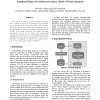Free Online Productivity Tools
i2Speak
i2Symbol
i2OCR
iTex2Img
iWeb2Print
iWeb2Shot
i2Type
iPdf2Split
iPdf2Merge
i2Bopomofo
i2Arabic
i2Style
i2Image
i2PDF
iLatex2Rtf
Sci2ools
ICPR
2004
IEEE
2004
IEEE
Exploring Human Eye Behaviour using a Model of Visual Attention
It is natural in a visual search to look at any object that is similar to the target so that it can be recognised and a decision made to end the search. Eye tracking technology offers an intimate and immediate way of interpreting users' behaviours to guide a computer search through large image databases. This paper describes experiments carried out to explore the relationship between gaze behaviour and a visual attention model that identifies regions of interest in image data. Results show that there is a difference in behaviour on images that do and do not contain a clear region of interest.
| Added | 09 Nov 2009 |
| Updated | 09 Nov 2009 |
| Type | Conference |
| Year | 2004 |
| Where | ICPR |
| Authors | Fred Stentiford, Oyewole Oyekoya |
Comments (0)

